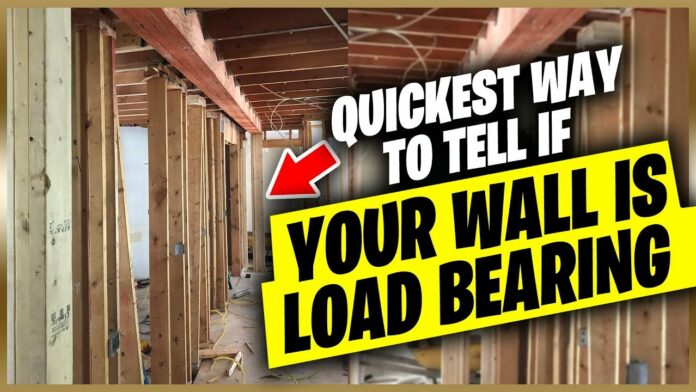This post will explain how to tell if a wall is load bearing. Whether you are building a brand-new home or remodeling an old one, you’re here for a reason. You need to know whether the wall you are developing or thinking about taking down is load-bearing. The response may be simpler than you believe.
How To Tell If A Wall Is Load-Bearing
In this article, you can know about how to tell if a wall is load bearing here are then details below;
Working with a professional no matter where you are in the construction procedure or remodeling procedure is suggested. Nevertheless, it is essential when handling your home’s structural integrity, which exists when determining load-bearing walls.
What Is A Load-Bearing Wall?
A bearing wall or bearing wall is a wall that is a structural component of the building. It isn’t just a divider, however an essential part of the building’s structural integrity. A load-bearing wall holds the weights of the structural components above it.
However, a load-bearing wall doesn’t usually bear the weight alone. It utilizes the structure below it to bear the weight that it has to bear. So it utilizes a load-bearing foundation to support it, permitting it to support the load above.
In skyscrapers, bearing walls are normally made from steel. Or at least the frame is. However, in real estate, they are made of wood, brick, or stone more often than not. This is different than a keeping wall, which bears the weight of traffics rathers than constructions.
Why Does It problem If A Wall Is Load Bearing?
The significance of load-bearing walls is not ones you want to overlook. After all, a house requires multiple bearing walls, or it will collapse. Non-load-bearing walls can be gotten rid of quickly and won’t affect the integrity of the home.
However, a bearing wall can not just be gotten rid of unless you are willing to run the risk of the security of your family. However, one can be gotten rid of just as a brand-new one is constructed to replace it. This isn’t easy and requires to be done thoroughly.
How to Tell If A Wall Is Load Bearing
If you’re thinking about taking walls downs or moving them, you most likely require to understand if the walls are load-bearing. There are a couple of various methods to find this out, and they are all ways that anybody can use.
When it concerns taking the wall down, you must speak with an expert. Even if you just consult them before starting, it’s better than being overwhelmed with whether or not you’re keeping the structural integrity.
Spot Support Beams
The first thing that you can search for is assistance beams. If you have a basement, this is a simple method to spot them. Any beam or pillars in the basement likely has bearing walls above it. However, if you do not have a basement, things are harder.
Whats you can do is see if you can discover a crawlspace under your house. If there is one, you can find support walls and beams under there that will bear walls above them. Don’t remove these walls without expert aid.
Note: Most support beams are made from steel or concrete.
Finding Floor Joists
Now, if you carry on as much as the first flooring, you can look at the flooring joists. If you should open joists, then you can seen them. If not, you will require to use a stud-finder to find them. Generally, joists and studs are 16-in apart.
Parallel Or Not
This deals with floor joists or ceiling support. If the walls are operating perpendicular to the support, then there’s an good chance that they are load bearing. If the walls are correspondence, then there’s a really good chance they are not.
This is because, to support the upper floors, the walls need to cover several joists instead of simply run along with one. If the wall only runs forward one joist, it might slip, fracture, or collapse. So perpendiculars walls are more likely to be load-bearing.
Go To The Top
Finally, if all else fails, you can have a look at the exposed rafters in your attic if you have one. You’ll need to look carefully for all of the hints with this method. If there are any walls-up there, then lowers walls are load-bearing.
But that’s just one method to see. Since you can also identify if the walls below are load-bearing by seeing any crossover boards. If the boards don’t run across the ceiling, then the wall holding the seam up is load-bearing.
Gaps
This ones may seem obvious, but it’s one that lots of people forget to examine. You see, some of the walls are only supported on the ends. However, all bearing walls will reach the ceiling. So if a wall has an gaps at the top, it isn’t load-bearing.
Building Load-Bearing Walls
Image from H&L Environmental Demolition Inc
Taking down load-bearing walls is a danger. However, developing them is just as crucial. If you don’t have adequate bearing walls, your home will collapse in time. You need all the supports you can get. Literally.
Mark Load-Bearing Walls.
Would not it be nice if the walls in the home you redesign were marked a different color if they were load-bearing? Well, be that act of random compassion to the future property owner or your future self and marks those walls.
You can either writes structural, LB, or even S, and many people will get the picture. If you’re feeling generous, utilize a highlighter to mark an X and compose a “load-bearing wall” with a Sharpie. If you make errors, check out this Sharpie on the wood guide.
Start At The Bottom.
Putting a bearing wall on the very first floor with nothing to support it listed below is pointless. You must begin at the foundation. You require to ensure there are assistance beams below the wood structure.
The beams can be constructed of concrete or steel. However, they require to be prepared before the build starts. Otherwise, someones will have to crawl under the house afterwards, and it will be ten times more difficult.
Get An Architect.
There truly is no simple way to figure the number of bearing walls you require. After all, a little one-story house may need nothing but four external walls. Nevertheless, a two-and-half-story house with 3000 sqft will need numerous load-bearing walls.
You need a professional and designer for this part of creating your house. You can include sheetrock, set up non-load-bearing partitions, and paint by yourself. Now, you can even set up electric outlets if you have experience with them.
Nevertheless, winging it on structural assistance never turns out well. So if you spends money on something, let it be this.
How To Build A Partition.
This structured approach works both for bearing walls above the sublevel and on partitions that are non-load-bearing. This is one of the most convenient actions of developing a house and is a great thing to experiment with beginners.
Measuring Space.
The 1st thing you must do is measure the space where the wall will go. Remember that if a door remains in the wall, you need to keep the top board strong while accommodating the door with partial studs.
Measure across the flooring and ceiling to ensure they are the same length. In older houses, sometimes the floor and ceiling will be various, making things much more difficult. After you measure this, determine the vertical space on the left and right.
Cutting Horizontal Boards.
You will require two horizontal boards that run the length of the space you measured—a procedure the area and the boards a minimum of twice before cutting. Then measure the marks you made. Then, finally, cut the two boards.
Cutting Studs.
Studs will need to be placed every 16-inches. So mark the horizontal boards every 16-inches. It’s alright if the end is less than 16 inches; it’s much better to be less than more. So include an additional if requirement be. Then, start cutting.
Each board will require to be the same length. It’s crucial to remember to take out three inches for the 2x4s on the top and bottom. So if your ceiling is 70 ″, then cuts the studs to be 67 to accommodates them.
Screwing Studs In.
Afters all the boards are cut, screw the 2 end boards on. This will ensure that you do not leave an overhang. You can put the boards where they need to go and leave them whiles you screw the other’s in.
Use two screw’s for each end of each boards, so four screws per board. It’s importants everything is flush; otherwise, you will not be able to screw anything else in, including drywall, properly. Take your time and do things right.
Placing The Wall.
Develop the wall while putting down on the flooring where it needs to go when you’re done. When you end up screwing all of the boards in, you can start putting the wall up. You’ll require a minimum of 2 people.
When it is in place, utilize a rubber mallet to make sure that it is level. Hold the level on each sides and hammer the wall with an mallet until it is in place. Do so slowly and easily, so you do not break any of the boards.
Now you’re done! This works for both load-bearing and non load-bearing walls. Do not forget to mark it either way so nobody else will have difficulty determining bearing walls in this house once again.

